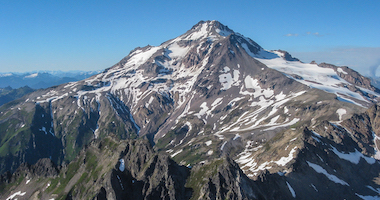Most Popular Entries
On The Map
Hope you guys brought plenty of crackers
Posted by: Tony on 6/20/2012 at 10:52 am
This message is from ontario canada. we’re so proud of you ashley and so happy you and your team are safe. a moment in history for you all!!!! congratulations!
with love anick
Posted by: anick mohan on 6/19/2012 at 6:58 pm
RMI Guide Mark Tucker checks in from high camp on Kilimanjaro
On The Map
Hi Dad!! Kalvin and I have been enjoying following along with your trip! Hope everyone made it to the top and everyone is feeling good!!
Can’t wait to hear all your stories!!
Posted by: Justine Prieve on 2/20/2011 at 7:01 am
Message to Phillip from Justin: Hi Carl.
Sidenote - did everyone know that Jan’s middle name is Maria? True story!!!
Posted by: Justin Osborne on 2/19/2011 at 4:17 pm
Posted by: Alan Davis, Mike Bennett, Robert Whyte
Categories: Expedition Dispatches Mount Rainier
Elevation: 11,200'



Despite a skiff of snow and some much cooler winds, the clouds lifted and we awoke to a peaceful sunrise. We climbed above Camp Muir and enjoyed the sunrise from Ingraham Flats.
RMI Guide Alan Davis
Posted by: Pete Van Deventer, Leif Bergstrom, Erika Birkeland
Categories: Expedition Dispatches Mt. McKinley
Elevation: 11,000'
Thursday, May 18, 2022 - 12:46 am PT
We took our time over coffee and breakfast burritos this morning, enjoying the slow start and the warming sun that doesn't hit camp until 9 am. Satiated, we left camp and moved quickly downhill to our cache at 9600', relishing the opportunity to stride it out and cover ground. We passed a lot of teams headed towards 11,000' Camp, slowly trudging under the loads of big packs and full sleds. With our cache retrieved, we worked out way back uphill to our cozy camp. Overall, 11,000' Camp felt like it doubled in size today and lots of folks were strolling around, enjoying a warm afternoon. We'll look to continue our momentum tomorrow caching a load of fuel and food up high near Windy Corner.
RMI Guides Pete, Leif, Erika, and team
Wonderful reading the news. We are with you in spirit. Enjoy. Love, Barbara
Posted by: Barbara Corona on 5/20/2022 at 6:11 am
Posted by: Pete Van Deventer, Leif Bergstrom, Erika Birkeland
Categories: Expedition Dispatches Mt. McKinley

Sunday, May 15, 2022 - 1:10 am PT
It was an auspicious start to our May 12 Denali Expedition today. When we called K2 in the morning to ask how things looked they replied "unlimited visibility and perfect". We rallied a hasty breakfast and headed for the hanger. We had gotten all of our bags set yesterday, so it didn't take much to get the planes loaded and launched. The pilots were taken with how clear and gorgeous the day was too, taking several detours to show us stunning corners of the Alaska Range on the way.
We landed and hit the ground running. Fully loaded sleds and packs were an indication of the magnitude of our undertaking, but the team cruised through the 5.5 miles of mellow glacier travel, and we rolled in to our first camp looking fresh. Everyone is fed and tucked into warm sleeping bags and as we write, a stunning full moon is rising over Mt. Hunter.
We plan to carry a load up towards Kahiltna pass tomorrow and then return to camp. We'll be in touch.
RMI Guides Pete Van Deventer, Leif Bergstrom, Erika Birkeland, and team


RMI Guide Garrett Stevens calls from the Aconcagua summit!
On The Map
Congratulations Beng Hoe and rest of the team. Been following the blog daily. The voice dispatch was a nice touch! Enjoy the hike down and stay safe.
Posted by: Helen Lim on 1/13/2014 at 5:34 pm
Congratulations to David and the whole team on your great accomplishment! Have a safe trip down.
Posted by: Lori on 1/13/2014 at 1:22 pm


On The Map
Thanks for the video. Cute dogs. Do they live up there or someone bring them with?
Posted by: Kris on 3/4/2013 at 6:03 pm
Hey team Orizaba! Bill’s wife here. Glad to hear it’s going well. Good luck on Ixta! I teach 4th graders and am showing my class your blogs.
Posted by: Kris Westberg on 3/4/2013 at 10:19 am
Posted by: Ben Luedtke, Erika Birkeland
Categories: Expedition Dispatches North Cascades
Elevation: 7,300'

July 22, 2024 - 5:48 pm PT
We started the morning with riddles from Ben. We continued to make our way up steep terrain and sandy trails, seeing our first patches of snow. We shooed a brave marmot (Jerry) away at snack time. Rock hopping, we made our way to high camp. Setting up camp in a beautiful snowy basin, we spent the afternoon honing our snow travel skills.
-RMI Climber, Miranda Chisholm

PC: Ben Luedtke
On The Map
So proud of you Nancy! You are a great inspiration to me. I even did a minor climb…I went to the top of Diamond Head. Keep you’re spirits up. You’re in my thoughts & prayers everyday. Love following you’re experience as it is happening.
Posted by: Cece on 3/28/2014 at 12:06 am
You all look amazing!! SO proud of you!! The weather looks beautiful.
Posted by: Dada Glaser on 3/27/2014 at 6:49 am























Congrats Kelly, Brian, (and possibly Jen)! :)
(Btw, the category of this blog should be changed to Mt. Rainier)
Posted by: -shae- on 6/30/2012 at 3:33 pm
Boo-Yah! Happy Birthday, LB! Hope everyone on the team made it and the trip back is gravy! Congrats to everybody!
Posted by: tyre on 6/30/2012 at 2:55 pm
View All Comments